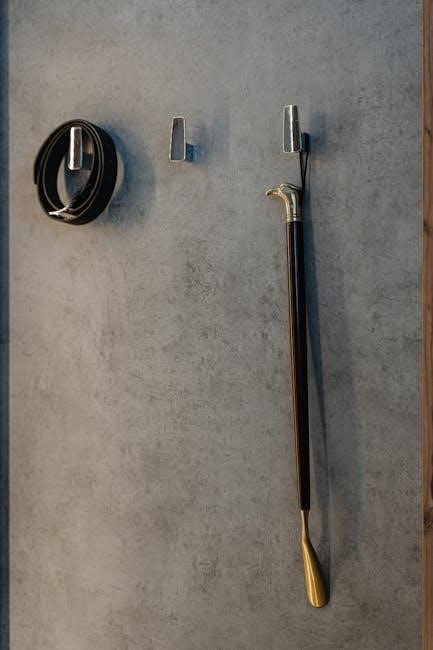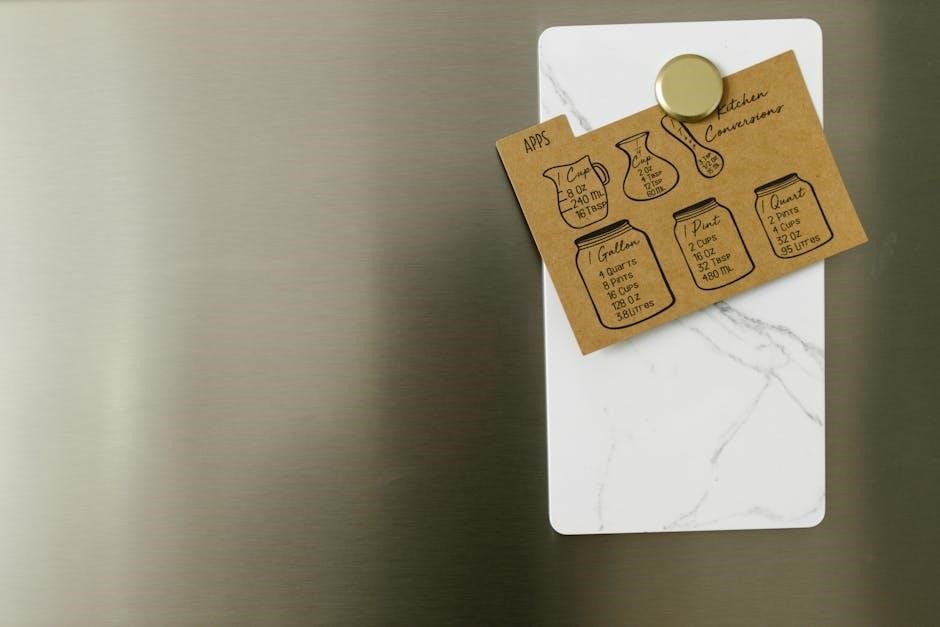Accurate belt measurement ensures a perfect fit and prevents damage. It involves using a tape measure or existing belt to determine size. Proper measurement is straightforward once you know the basics.
How to Measure Your Waist for a Belt
Wrap a tape measure around your natural waistline, keeping it snug but not tight. Note the measurement to ensure a proper belt fit.
2.1 Using a Tape Measure
To measure your waist for a belt using a tape measure, locate your natural waistline, typically just above the hipbone. Wrap the tape measure around this area, ensuring it is snug but not overly tight. Keep the tape measure level and parallel to the floor for an accurate reading. The measurement where the tape meets indicates your waist size. For the best fit, avoid holding your breath or pulling the tape too tight, as this can lead to an inaccurate size. This method is the most reliable way to determine your belt size, ensuring comfort and functionality. Always double-check the measurement to ensure consistency and accuracy.
2.2 Determining the Ideal Height
Determining the ideal height for your belt involves identifying where you naturally wear your belts. This is typically around your waistline, just above the hipbone. To find this, stand up straight and locate the natural crease where your pants or skirt sits. This crease indicates your natural waistline. For most people, the belt should sit comfortably at this height, neither too high nor too low. If you plan to wear the belt with specific pants, such as low-rise or high-rise styles, adjust the height accordingly. Ensure the tape measure is level and parallel to the floor when measuring. This step ensures the belt will sit comfortably and function properly. Accurate height determination is crucial for both aesthetics and practicality.

How to Measure an Existing Belt
To measure an existing belt, lay it flat on a clean surface. Ensure the belt is straight and not twisted. Locate the buckle and the holes used for fastening. Place the tape measure at the hole you most commonly use and extend it to the end of the belt where it meets the buckle. Note the measurement in inches or centimeters. This will give you the length of the belt from the buckle to the most used hole. For accuracy, avoid stretching the belt material, especially if it is leather, as it may have some give. This method provides a reliable reference for determining your belt size when purchasing a new one. Always double-check the measurement to ensure precision.
Converting Pant Size to Belt Size
Converting pant size to belt size is a practical approach when you don’t have a tape measure handy. Generally, your belt size corresponds to your waist size, which is the same as your pant size. For example, if your pants are size 32 inches, your belt size is typically 32 inches. However, some styles may require adding 1-2 inches to your pant size for the best fit. To ensure accuracy, measure your waist at the height you plan to wear the belt. If you’re between sizes, opt for the next size up for comfort. This method is a helpful guideline, but always check the sizing chart of the specific belt you’re purchasing, as variations can occur between brands and styles.
Choosing the Right Belt Type for Your Needs
Selecting the right belt type depends on your lifestyle, preferences, and the occasion. Leather belts are a classic choice, offering durability and a sophisticated look, suitable for both formal and casual wear. Fabric belts are ideal for a lightweight, breathable option, perfect for summer or active lifestyles. Chain belts, on the other hand, offer a trendy, modern aesthetic and are often more durable than traditional materials. Consider the buckle style as well—prong, slide, or automatic buckles each offer unique functionality. For example, automatic buckles provide quick adjustments, while slide buckles allow for effortless customization. Additionally, think about the thickness of the belt; thicker styles are great for heavy-duty use, while slim belts are better for formal attire. Your belt should complement your wardrobe while meeting your practical needs.

Understanding Standard Belt Sizes
Standard belt sizes are designed to align with your waist measurement, ensuring a proper fit. Typically, belt sizes are numbered and correspond to your waist size in inches or centimeters. For example, a 32-inch waist usually matches a 32-inch belt size. However, some brands use alphanumeric sizing, such as S, M, or L, which can vary between manufacturers. When measuring, the distance from the buckle to the middle hole of the belt often determines the size. If you’re unsure, adding 2 inches to your pant size can provide a good estimate. Always check the sizing chart for specific brands, as there may be slight variations. Accurate sizing ensures comfort and functionality, preventing the belt from being too tight or too loose. Understanding standard sizes simplifies the process of selecting the right belt for your needs.

Ensuring Measurement Accuracy
Accurate belt measurement is crucial for a proper fit. To ensure precision, always measure at the same height where you intend to wear the belt. Use a flexible tape measure, as rigid tools like rulers can lead to inaccurate results. When measuring an existing belt, lay it flat and measure from the buckle’s edge to the most-used hole. For the best fit, this measurement should match your waist size. If measuring your waist, wrap the tape snugly around your natural waistline, avoiding any gaps or overly tight wrapping. Double-checking your measurements ensures reliability. For v-belts or specialty belts, specific tools may be required to measure correctly. Consistency in method and tool use is key to achieving accurate results every time.
Common Mistakes to Avoid When Measuring
When measuring for a belt, several common errors can lead to an ill-fitting belt. One major mistake is using a rigid ruler instead of a flexible tape measure, which can cause inaccurate results. Another error is measuring at the wrong height; ensure you measure where the belt will actually be worn. Neglecting to consider the thickness of the belt material can also lead to size discrepancies. Additionally, not accounting for stretch or shrinkage in materials like leather or fabric can affect fit. Measuring too loosely or too tightly is another pitfall; the tape should be snug but not constricting. Lastly, assuming your belt size matches your pant size without verification can result in an improper fit. Avoiding these mistakes ensures a more accurate and comfortable measurement process.
How to Measure Different Types of Belts
Measuring belts varies by material. For leather belts, measure from the buckle to the most used hole, accounting for potential stretching. Fabric belts require a flexible tape measure to ensure accuracy, while chain belts involve measuring link lengths or total length to determine size. Using a string or flexible tool to wrap around the waist and compare against the belt can provide a universal method. Consider belt thickness and buckle size, and avoid common mistakes like over-stretching or not accounting for material flexibility. Special tools may enhance accuracy, especially for complex designs. Adjust techniques based on material properties to ensure the best fit.
9.1 Leather Belts
Measuring leather belts requires careful attention to their natural stretch and thickness. To determine the size accurately, lay the belt flat and measure from the buckle’s edge to the most used hole. This ensures the fit accounts for potential stretching over time. Use a flexible tape measure or a string to wrap around your waist at the desired height, then compare it to the belt’s length. For an existing belt, measure from the buckle to the hole that fits best, ensuring the tape is not pulled too tight. Leather belts may vary slightly in size due to material flexibility, so consider this when choosing your size. Avoid over-stretching the belt during measurement, as this can lead to inaccuracies. Always compare your waist measurement to the belt’s length for the best fit.
9.2 Fabric Belts
Measuring fabric belts involves similar steps to leather belts but requires attention to their flexibility and potential stretch. Lay the belt flat and measure from the buckle’s edge to the farthest hole. This ensures the length accounts for any material give. Use a flexible tape measure or a string to wrap around your waist at the desired height, then compare it to the belt’s length. For an existing fabric belt, measure from the buckle to the most used hole, ensuring the tape is not overly tight. Fabric belts may stretch more than leather, so consider this when choosing your size. Avoid pulling the belt too taut during measurement to ensure accuracy. Proper fit is essential for both comfort and functionality, making precise measurement crucial for the best results.
9.3 Chain Belts
Measuring chain belts requires a slightly different approach due to their adjustable nature and lack of holes. To determine the correct size, wrap a flexible tape measure or a piece of string around your waist at the desired height to find your natural waist circumference. Then, lay the chain belt flat and measure its length from the buckle to the point where it would meet when fastened. Since chain belts are typically adjustable, ensure the measurement aligns with your waist size by counting the links or using the buckle’s sliding mechanism. Avoid overtightening, as chain belts are designed to sit comfortably without excessive pressure. Proper measurement ensures the belt neither sags nor digs into your clothing, providing both functionality and style. Accurate sizing is essential for optimal comfort and aesthetic appeal.

The Importance of Proper Belt Fit
A proper belt fit is essential for both comfort and functionality. A belt that is too tight can restrict movement and cause discomfort, while one that is too loose may not secure clothing effectively. Ensuring the right fit prevents unnecessary strain on the belt, extending its lifespan. Additionally, a well-fitting belt enhances the overall appearance, complementing an outfit and boosting confidence. Proper measurement ensures the belt sits naturally at the waistline, avoiding sagging or pinching. It also supports optimal performance, especially for work or active belts, where reliability is key. Prioritizing a precise fit guarantees style, comfort, and durability, making it a critical step in selecting the right belt for any occasion.
Accurate belt measurement is key to ensuring comfort, functionality, and style. By following the steps outlined in this guide, you can determine your ideal belt size and type. Whether measuring your waist, an existing belt, or converting pant size, proper techniques guarantee the best fit. Avoiding common mistakes, such as improper placement or incorrect tools, ensures precision. The right belt enhances your appearance, supports your clothing, and provides long-lasting durability. Remember, a well-fitting belt is an essential accessory that combines practicality and aesthetics. With this guide, you now have the knowledge to measure and choose the perfect belt for any occasion, ensuring confidence and comfort in your daily life.
